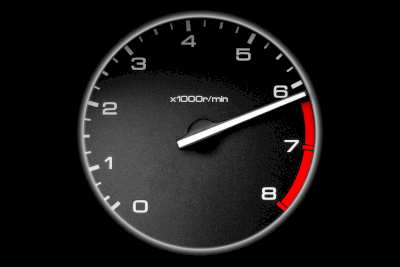What Is a Tachometer?

A tachometer is a measuring instrument that measures the number of revolutions or rotational speed of an object in rotational motion.
Although the rate of rotation is originally expressed as an angular velocity, it is often expressed industrially as the number of revolutions in a certain period, such as revolutions per minute (rpm), so instruments that measure the speed of rotation are generally called tachometers.
There are two types of tachometers: those that measure by contact with a rotating object and those that measure by non-contact. The contact type presses the contactor directly against the rotating object for quick measurement. The non-contact type measures by affixing a reflective mark to the rotating object or attaching a sensor. High-speed rotating objects and high-temperature objects can also be measured.
A tachometer is mainly used to maintain rotating equipment and to measure the rotational speed of engines, motors, generators, turbines, etc.
Uses of Tachometers
Tachometers measure the number of rotations or rotational speed of rotating objects by contact or non-contact methods. Examples include engines and other internal combustion engines, motors, turbine generators, refrigeration equipment, and a wide range of other industrial products. A familiar example is the engine RPM displayed on the instrument panel of an automobile.
Principle of Tachometers
Tachometers are broadly classified into mechanical and electronic types. Mechanical tachometers have been in use since ancient times and combine a decimal gear mechanism for counting revolutions and a timing mechanism for operating the mechanism for a certain period. It measures the number of revolutions made in a given time.
Contact tachometers consist mainly of a permanent magnet, a detection coil, and a magnetic circuit. The coil detects an induced voltage proportional to the magnetic flux change caused by rotation. This voltage is converted and used as an output signal of rotation. Instruments that continuously measure and indicate the instantaneous value of the speed of rotation, i.e., angular velocity, convert the angular velocity into other efficiently handled physical quantities that are proportional to it, such as centrifugal force, fluid viscous force, or electromotive force due to electromagnetic induction.
There are many methods of non-contact tachometers. The reflective mark method counts the reflected light from a reflective tape on the rotating body. In contrast, the magnetic force method detects changes in the magnetic field from a magnet on the rotating body. The sensor method counts signals from a sensor attached to the rotating body. There are several types of sensors, including optical, magnetic, and electromagnetic induction types.
Types of Tachometers and Measurement Methods
Tachometers are classified into contact type, non-contact type, dual-use type, sensor type, etc.
1. Contact Type Tachometers
The mechanical type is used by pressing against the center of a rotating shaft. It uses gears to count the number of revolutions made at a given time. Pressing the push button usually takes 3 seconds, and the number of processes is displayed in rpm. There are various types of electronic types. The rpm can be read directly by pressing the handheld-type tachometers against the center of the axis of rotation.
When a circumferential speed ring is attached to the tachometers and pressed against the circumferential surface of the rotating shaft, the circumferential speed can be measured. Using contact tachometers to measure equipment rotating at high speed is dangerous. It is safer to use it for low rates.
2. Non-Contact Tachometers
There are various types of non-contact tachometers, such as reflective mark type, magnetic type, and sensor type. Display methods include analog and digital. Usually, both analog and digital outputs are provided. In both types, the detected rotation signal is amplified and converted to DC voltage for use as the rotation output signal.
In the reflective mark method, reflective tape is attached to the outer circumference of the rotation axis, and visible red light or LED is emitted from the tachometers to count the light reflected by the reflective mark. The light reflected by the reflective mark is counted, converted to the number of revolutions, and displayed on display. The measuring range varies depending on the number of reflective tapes. The detection distance is about 20 to 300 mm. The magnetic methods are tachometers that magnetize a rotating shaft and detect changes in magnetic flux.
3. Contact/Non-Contact Tachometers
Non-contact type tachometers can be converted into contact tachometers by attaching a contact adapter and a rotating contactor to the head of handy-type non-contact tachometers.
4. Sensor Type Tachometers
This type of tachometer counts by attaching sensors to the rotating shaft. There are optical, magnetic, electromagnetic induction, and other types. Most of them are non-contact types.
5. Optical Type Tachometers
This is a method in which a disk with a slit is mounted on a rotating body, light is incident, and the number of slits passing through the disk is counted. It has a fast response time.
6. Magnetic Type Tachometers
A magnet is attached to the motor to detect changes in the magnetic field caused by rotation. The magnetic type is resistant to water, oil, and other contaminants. It can be used in environments prone to contamination, such as industrial sewing machines and machine tools.
7. Electromagnetic Induction Type Tachometers
This method detects changes in the magnetic field when the sensor coil passes through a projection on the rotating body. This method is suitable for the measurement of high-speed rotation. This method is used for ABS systems in automobiles. FFT tachometers are now available that estimate and measure rotation speed by detecting vibration and noise, without a rotation sensor or other special equipment.